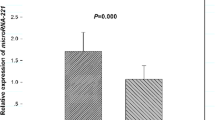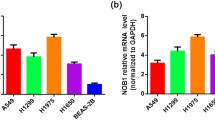Abstract
Human Cripto-1 (CR-1) plays an important oncogenic role during tumorigenesis and is overexpressed in a wide range of carcinomas, yet little is known about CR-1 in non-small cell lung cancer (NSCLC). The aims of this study were to detect CR-1 expression in NSCLC and to analyze its association with prognosis of NSCLC patients. The expression of CR-1 messenger RNA (mRNA) and protein in 35 cases of NSCLC and corresponding noncancerous tissue samples was examined by quantitative real-time reverse transcription–polymerase chain reaction (qRT–PCR) and Western blotting. Immunohistochemistry was performed to detect the expression of CR-1 in 128 NSCLC tissues. The expression levels of CR-1 mRNA and protein in NSCLC tissues were significantly higher than those in corresponding noncancerous tissues (P < 0.001). A high level of CR-1 expression was correlated with poor tumor differentiation (P = 0.002), tumor–node–metastasis (TNM) stage (P = 0.004), and lymph node metastasis (P = 0.001). The results of the Kaplan–Meier analysis indicated that a high expression level of CR-1 resulted in a significantly poor prognosis of NSCLC patients. Multivariate Cox regression analysis revealed that CR-1 expression level was an independent prognostic parameter for the overall survival rate of NSCLC patients. Our data suggest that the high expression of CR-1 may play an important role in the progression of NSCLC, and CR-1 expression may offer a valuable marker for predicting the outcome of patients with NSCLC.




Similar content being viewed by others
References
Chen Z, Wang T, Cai L, Su C, Zhong B, Lei Y, et al. Clinicopathological significance of non-small cell lung cancer with high prevalence of Oct-4 tumor cells. J Exp Clin Cancer Res. 2012;31:10.
Smith RA, Cokkinides V, Brawley OW. Cancer screening in the United States, 2009: a review of current American Cancer Society guidelines and issues in cancer screening. CA Cancer J Clin. 2009;59:27–41.
Diamandis EP, Goodglick L, Planque C, Thornquist MD. Pentraxin-3 is a novel biomarker of lung carcinoma. Clin Cancer Res. 2012;17:2395–9.
Zhang Y, Ying X, Han S, Wang J, Zhou X, Bai E, et al. Autoantibodies against insulin-like growth factor -binding protein-2 as a serological biomarker in the diagnosis of lung cancer. Int J Oncol. 2013;42:93–100.
Jia JW, Li KL, Wu JX, Guo SL. Clinical significance of annexin II expression in human non-small cell lung cancer. Tumor Biol. 2013;34:1767–71.
Bianco C, Castro NP, Baraty C, Rollman K, Held N, Rangel MC, et al. Regulation of human Cripto-1 expression by nuclear receptors and DNA promoter methylation in human embryonal and breast cancer cells. J Cell Physiol. 2013;228:1174–88.
Nagaoka T, Karasawa H, Turbyville T, Rangel MC, Castro NP, Gonzales M, et al. Cripto-1 enhances the canonical Wnt/β-catenin signaling pathway by binding to LRP5 and LRP6 co-receptors. Cell Signal. 2013;25:178–89.
Das AB, Loying P, Bose B. Human recombinant Cripto-1 increases doubling time and reduces proliferation of HeLa cells independent of pro-proliferation pathways. Cancer Lett. 2012;318:189–98.
De Luca A, Lamura L, Strizzi L, Roma C, D'Antonio A, Margaryan N, et al. Expression and functional role of CRIPTO-1 in cutaneous melanoma. Br J Cancer. 2011;105:1030–8.
Yoon HJ, Hong JS, Shin WJ, Lee YJ, Hong KO, Lee JI, et al. The role of Cripto-1 in the tumorigenesis and progression of oral squamous cell carcinoma. Oral Oncol. 2011;47:1023–31.
Lawrence MG, Margaryan NV, Loessner D, Collins A, Kerr KM, Turner M, et al. Reactivation of embryonic nodal signaling is associated with tumor progression and promotes the growth of prostate cancer cells. Prostate. 2011;71:1198–209.
Strizzi L, Margaryan NV, Gilgur A, Hardy KM, Normanno N, Salomon DS, et al. The significance of a Cripto-1 positive subpopulation of human melanoma cells exhibiting stem cell-like characteristics. Cell Cycle. 2013;12:1450–6.
Rangel MC, Karasawa H, Castro NP, Nagaoka T, Salomon DS, Bianco C. Role of Cripto-1 during epithelial-to-mesenchymal transition in development and cancer. Am J Pathol. 2012;180:2188–200.
Wu Z, Weng D, Li G. Quantitative proteome analysis of overexpressed Cripto-1 tumor cell reveals 14-3-3γ as a novel biomarker in nasopharyngeal carcinoma. J Proteomics. 2013;83:26–36.
Bianco C, Rangel MC, Castro NP, Nagaoka T, Rollman K, Gonzales M, et al. Role of Cripto-1 in stem cell maintenance and malignant progression. Am J Pathol. 2010;177:532–40.
Watanabe K, Meyer MJ, Strizzi L, Lee JM, Gonzales M, Bianco C, et al. Cripto-1 is a cell surface marker for a tumorigenic, undifferentiated subpopulation in human embryonal carcinoma cells. Stem Cells. 2010;28:1303–14.
Zhang JG, Zhao J, Xin Y. Significance and relationship between Cripto-1 and p-STAT3 expression in gastric cancer and precancerous lesions. World J Gastroenterol. 2010;16:571–7.
Bianco C, Strizzi L, Mancino M, Rehman A, Hamada S, Watanabe K, et al. Identification of cripto-1 as a novel serologic marker for breast and colon cancer. Clin Cancer Res. 2006;12:5158–64.
Zhong XY, Zhang LH, Jia SQ, Shi T, Niu ZJ, Du H, et al. Positive association of up-regulated Cripto-1 and down-regulated E-cadherin with tumour progression and poor prognosis in gastric cancer. Histopathology. 2008;52:560–8.
Groome PA, Bolejack V, Crowley JJ, Kennedy C, Krasnik M, Sobin LH. The IASLC Lung Cancer Staging Project: validation of the proposals for revision of the T, N and M descriptors and consequent stage groupings in the forthcoming (seventh) edition of the TNM classification of malignant tumours. J Thorac Oncol. 2007;2:694–705.
Mallikarjuna K, Vaijayanthi P, Krishnakumar S. Cripto-1 expression in uveal melanoma: an immunohistochemical study. Exp Eye Res. 2007;84:1060–6.
Tysnes BB, Satran HA, Mork SJ, Margaryan NV, Eide GE, Petersen K, et al. Age-dependent association between protein expression of the embryonic stem cell marker Cripto-1 and survival of glioblastoma patients. Transl Oncol. 2013;6:732–41.
Gong YP, Yarrow PM, Carmalt HL, Kwun SY, Kennedy CW, Lin BP, et al. Overexpression of Cripto and its prognostic significance in breast cancer: a study with long term survival. Eur J Surg Oncol. 2007;33:438–43.
Acknowledgments
This work was supported in part by a grant from “Twelve-Five Plan” the Major Program of Nanjing Medical Science and Technique Development Foundation (Molecular Mechanism Study on Metastasis and Clinical Efficacy Prediction of Non-small Cell Lung Cancer) (LK-Yu).
Conflicts of interest
None
Author information
Authors and Affiliations
Corresponding author
Rights and permissions
About this article
Cite this article
Xu, CH., Sheng, ZH., Hu, HD. et al. Elevated expression of Cripto-1 correlates with poor prognosis in non-small cell lung cancer. Tumor Biol. 35, 8673–8678 (2014). https://doi.org/10.1007/s13277-014-2039-1
Received:
Accepted:
Published:
Issue Date:
DOI: https://doi.org/10.1007/s13277-014-2039-1




